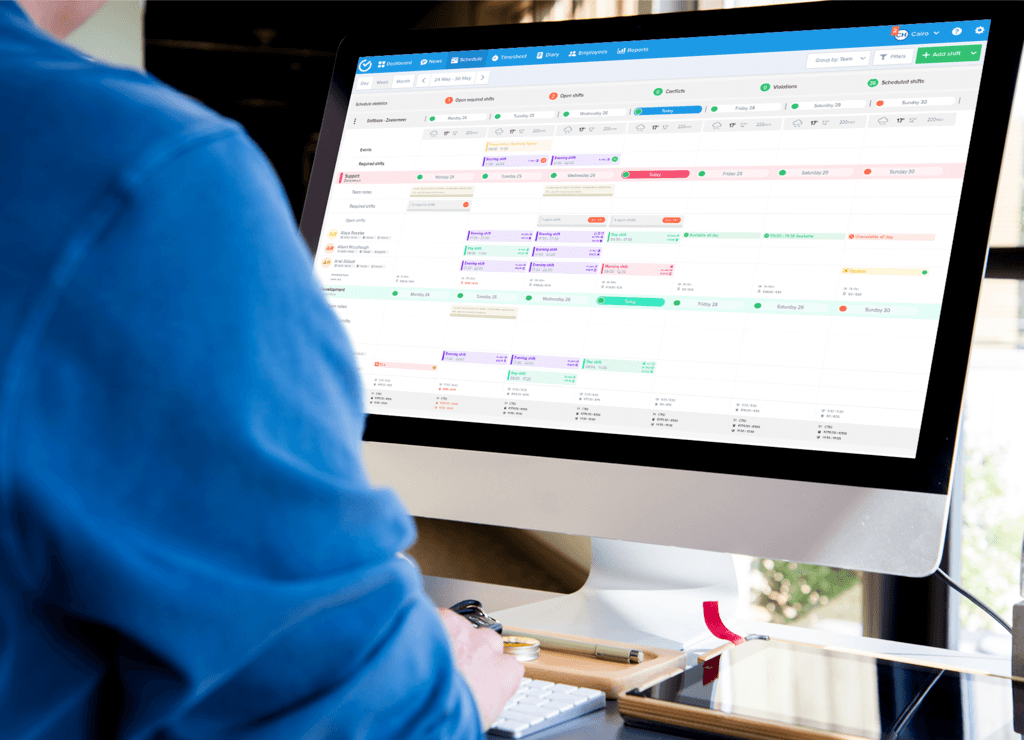This article provides a comprehensive examination of employee timekeeping practices, delving into its fundamental principles and underscoring its pivotal significance.
What is employee timekeeping?
Employee timekeeping refers to the process of tracking and recording the hours worked by employees in a business or organization. It involves monitoring when employees start and end their work shifts, as well as any breaks taken during those shifts.
Timekeeping systems can vary, ranging from traditional methods like manual timecards or punch clocks to modern digital solutions such as electronic time clocks or software applications. Accurate timekeeping is essential for various purposes, including calculating payroll, managing attendance, ensuring compliance with labor laws, and analyzing workforce productivity.
The importance of employee timekeeping
Payroll accuracy and efficiency
Accurate employee timekeeping is pivotal for maintaining precise payroll records. By meticulously tracking employee hours, businesses ensure that every worker is fairly compensated for their efforts in alignment with wage and hour laws.
This process also streamlines payroll calculations and reduces the likelihood of errors, saving valuable time and resources. With an effective timekeeping system, businesses can confidently meet the requirements of the Fair Labor Standards Act (FLSA) and other labor laws, fostering trust and transparency between employers and employees.
Useful Read: Payroll Services Costs for Small Business: A Complete Breakdown
Compliance with labor laws and regulations
Employee timekeeping isn't solely about operational efficiency; it's a legal obligation for businesses of all sizes. A robust time and attendance tracking system ensures that companies adhere to labor laws, accurately recording hours worked and adhering to regulations regarding overtime, breaks, and meal periods.
This not only prevents potential legal disputes and penalties but also demonstrates a commitment to treating employees fairly and in accordance with the law.
Insights into workforce productivity and efficiency
Beyond compliance, effective employee timekeeping provides invaluable insights into workforce productivity and operational efficiency. By analyzing timekeeping data, businesses can identify patterns, trends, and areas for improvement.
This data empowers decision-makers to optimize employee schedules, allocate resources effectively, and enhance overall business performance. As a result, accurate records of employee time contribute directly to informed strategic decisions that drive the company's success.
Why decision-makers should prioritize employee timekeeping?

1. Addresses the concerns of company decision-makers
For company decision-makers, employee timekeeping goes beyond administrative tasks; it's a fundamental aspect of business strategy. By consistently tracking time and attendance, decision-makers ensure that labor costs are controlled, and budgets are adhered to.
Useful Read: How To Calculate the Cost Of An Employee + Free Template
This practice fosters a comprehensive understanding of how employee hours contribute to the organization's bottom line, allowing for better resource allocation and financial planning.
2. Aligns with broader business goals
Employee timekeeping isn't just about managing hours worked—it's a crucial element that aligns with broader business goals. Decision-makers can ensure that employees understand the significance of accurate time tracking in achieving operational excellence.
When employees are aware of how their time directly impacts the company's success, they become more engaged and committed to their roles, driving the organization toward its overarching objectives.
3. Enhances the overall operational efficiency
Effective employee timekeeping is like a backbone for a well-organized business. Decision-makers should recognize that accurate data on employee time directly influences the company's operational efficiency. When employee schedules are optimized based on data-driven insights, productivity increases, and unnecessary labor costs are minimized.
Moreover, streamlined time-tracking processes facilitated by timekeeping software benefit decision-makers by providing real-time information that supports informed managerial decisions.
Different types of employee timekeeping
Lets take a look at the different types of employee timekeeping:
1. Manual timekeeping system:
In a manual timekeeping system, employees track time by recording their hours worked using methods like manual timesheets or clocking in and out on paper. While this approach offers simplicity, it can be prone to errors and may consume valuable time for both employees and HR personnel.
Accurate record-keeping relies heavily on the diligence of individuals, and as a result, there's a potential for discrepancies between reported and actual hours worked. Despite its limitations, manual timekeeping may be suitable for smaller businesses with straightforward time-tracking needs.
2. Automatic timekeeping system:
An automatic timekeeping system revolutionizes the way we manage employee time. Through technology like time tracking software and timekeeping apps, employee time is automatically recorded and compiled. This system not only eliminates the risk of human error but also provides a comprehensive view of time spent on tasks, projects, or clients.
Automatic time tracking offers more accurate insights into employee productivity, which can then be linked to key performance indicators (KPIs) for better performance evaluation and resource allocation.
3. Hybrid timekeeping system:
The hybrid timekeeping system combines the best of both worlds: manual and automatic time tracking. Employees have the flexibility to input their time manually when necessary, while automatic time tracking covers the rest.
This approach is particularly useful in scenarios where some tasks are better suited for manual input and others benefit from the precision of automatic tracking. By accommodating various work styles and preferences, the hybrid system aims to provide a balanced and adaptable solution to manage employee time effectively.
The role of technology in revolutionizing timekeeping practices
Technology has ushered in a transformative era for tracking employees' time, especially for small businesses. Employee timekeeping software has emerged as a game-changer, offering efficient ways to manage and monitor both hours worked and paid time off.
Small businesses, often constrained by limited resources, now have access to sophisticated tools that streamline time tracking, reduce administrative burdens, and enhance accuracy. This technology empowers businesses to focus more on growth and less on manual timekeeping tasks, marking a significant shift in managing and optimizing employee time.
Implementing employee timekeeping successfully

Step 1: Define objectives and requirements
Before implementing a timekeeping system, clarify your organization's goals. Are you focused on accurate payroll, attendance tracking, or compliance? Outline specific requirements, such as the number of employees, locations, and any unique rules (e.g., overtime policies).
Step 2: Choose the right method
Choose the timekeeping method that suits your organization's needs:
-
Manual methods: This includes paper timesheets or manual entry into a spreadsheet. This is a cost-effective option for small businesses with a limited number of employees.
-
Electronic systems: These systems range from basic punch-card systems to advanced biometric systems or web-based applications. They offer more accuracy and reduce administrative burden.
-
Mobile apps: Consider mobile apps that allow employees to clock in and out using their smartphones. This is particularly useful for remote or mobile workforces.
Useful Read: What to Look For in a Clock In Clock Out System
Step 3: Research timekeeping software
If opting for electronic timekeeping, research and compare timekeeping software options. Look for features like real-time tracking, reporting capabilities, integration with payroll software, and mobile access.
Step 4: Involve stakeholders
Engage HR, department heads, and IT personnel to gather insights on system requirements and potential challenges. Their input will ensure the system aligns with various needs and expectations.
Step 5: Customization and configuration
Tailor the chosen software to your organization's specific needs. Set up employee profiles, shift work schedules, pay rates, and any overtime rules. This customization will ensure accurate tracking and reporting.
Step 6: Data security and compliance
Ensure the selected software adheres to data security standards and compliance regulations. Implement encryption, secure user authentication, and access controls to protect sensitive employee data.
Step 7: Employee training
Organize comprehensive training sessions to familiarize employees with the new timekeeping system. Cover how to clock in/out, request time off, and navigate any additional features. Offer ongoing support for questions and concerns.
Step 8: Communicate the change
Effectively communicate the transition to the new system to your employees. Explain the reasons behind the change, its benefits, and how it will impact their daily routines. Address any concerns and encourage their engagement.
Step 9: Pilot testing
Before full implementation, conduct a pilot test with a small group of employees. This trial run will help identify any issues, gather feedback, and fine-tune the system for a smoother rollout.
Step 10: Full deployment and monitoring
Once the system is refined, roll it out organization-wide. Monitor its performance closely during the initial phase to identify any glitches or difficulties. Address these promptly to ensure a successful transition.
By following these 10 steps, you'll create a comprehensive plan for implementing an employee timekeeping system that aligns with your organization's goals, streamlines processes, and ensures accurate record-keeping.
Leveraging insights from timekeeping data
Timekeeping data is a goldmine of invaluable insights that can revolutionize how we perceive employee attendance and monitor employee time. We unearth a profound understanding of our workforce dynamics by delving into this data.
We can deftly identify peak productivity hours, allocate project time more effectively, and address potential attendance issues. This data-driven approach empowers decision-makers to navigate challenges with precision and make informed choices that optimize both attendance and overall productivity.
Timekeeping data is a goldmine of invaluable insights that can revolutionize how we perceive employee attendance and monitor employee time. We unearth a profound understanding of our workforce dynamics by delving into this data.
We can deftly identify peak productivity hours, allocate project time more effectively, and address potential attendance issues. This data-driven approach empowers decision-makers to navigate challenges with precision and make informed choices that optimize both attendance and overall productivity.
Examples of insights gleaned from timekeeping data include:
-
Identifying peak productivity hours: By analyzing employee attendance patterns, we can uncover the hours when productivity is at its peak. This knowledge allows us to allocate complex tasks and important meetings during these times for optimal results.
-
Efficient project time allocation: Timekeeping data reveals the time spent on various tasks and projects. This insight helps us allocate resources more efficiently, ensuring projects stay on track and deadlines are met.
-
Addressing attendance concerns: Monitoring employee time provides visibility into attendance trends. By identifying patterns of absenteeism or tardiness, we can take proactive measures to address these concerns and maintain a reliable workforce.
By utilizing the insights provided by timekeeping data, leaders can make well-informed decisions that positively impact the organization's efficiency, employee satisfaction, and overall success. In an era where precision and optimization are paramount, harnessing the power of timekeeping data is not just a strategy but a necessity.
Best practices for employee timekeeping
-
Clear and comprehensive policies: Establish well-documented timekeeping policies that outline expectations for clocking in/out, breaks, and overtime. Clear policies set the foundation for accurate time tracking and ensure everyone understands the rules.
-
Utilize timekeeping software: Implementing dedicated timekeeping software streamlines the process, reduces errors, and allows for real-time tracking. This technology also simplifies reporting and auditing.
-
Accurate classification: Ensure employees are classified correctly (hourly, salaried, exempt, non-exempt) and that their time is accurately recorded according to their classification. Misclassification can lead to compliance issues.
-
Regular training and onboarding: Train new hires and conduct periodic refresher training sessions for all employees on how to use the timekeeping system. This reduces errors and ensures consistent usage.
-
Overtime management: Define clear rules for overtime and ensure supervisors approve overtime hours before they're worked. This prevents unauthorized overtime and helps manage labor costs.
-
Mobile accessibility: Offer mobile-friendly timekeeping options for remote or mobile employees. This flexibility makes clocking in/out easier and more convenient.
-
Supervisor approval: Require supervisor approval for time entries, adjustments, and overtime. This oversight ensures accuracy and prevents time theft or fraudulent reporting.
-
Audit trails: Maintain a comprehensive audit trail of time entries, changes, and approvals. An audit trail assists in resolving disputes, verifying accuracy, and maintaining accountability.
-
Regular audits and reviews: Conduct periodic audits of timekeeping records to identify discrepancies and ensure compliance. Regular reviews help catch errors and maintain data accuracy.
-
Integration with payroll: Integrate the timekeeping system with payroll software to eliminate manual data entry and reduce errors during payroll processing. This integration ensures accurate and timely compensation.
By adhering to these best practices, your organization can establish a robust and efficient employee timekeeping process that promotes accuracy, compliance, and overall workforce management effectiveness.


Boost your employee timekeeping with Shiftbase
In the digital age, traditional timekeeping methods often fall short. That's where Shiftbase comes in. Our SaaS solution for workforce management provides robust features for employee scheduling, time tracking, and absence management. Implementing Shiftbase in your workplace means elevating your employee timekeeping to a data-driven powerhouse.
Ready to maximize your employee timekeeping capabilities? Try Shiftbase for free for 14 days and experience the transformation!


